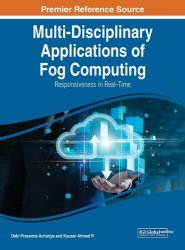 Название: Multi-Disciplinary Applications of Fog Computing: Responsiveness in Real-Time
Название: Multi-Disciplinary Applications of Fog Computing: Responsiveness in Real-TimeАвтор: Debi Prasanna Acharjya, Kauser Ahmed P.
Издательство: IGI Global
Год: 2023
Страниц: 300
Язык: английский
Формат: pdf (true)
Размер: 10.7 MB
Recently, several fog computing applications have been developed like IoT-based healthcare, 5G, blockchains, autonomous driving, and mobile wireless applications. They also address challenges such as data management, scalability, regulations, interoperability, device network human interfaces, security, and privacy. Further study on these applications is required to ensure this technology is utilized appropriately. Multi-Disciplinary Applications of Fog Computing: Responsiveness in Real-Time focuses on fog computing problems and solutions for various applications and covers the new approaches, architecture, and theoretical foundations in the fog paradigm of storage, communication, and computing. The book explores recent trends and challenges that lead to a potential course for the ideas, practices, norms, and strategies related to fog computing. Covering key topics such as data privacy, data analytics, and the internet of things, this reference work is ideal for computer scientists, policymakers, researchers, scholars, practitioners, instructors, and students.
Fog Computing is a paradigm that extends cloud computing capabilities to the network edge. Its foundations lie in understanding the theoretical principles and key concepts driving its development. This includes exploring architectural aspects which facilitate efficient and distributed data processing at the network edge. It involves examining the device and hardware support required for seamless fog computing operations, including edge devices, fog nodes, and network infrastructure. Different deployment approaches such as centralized, distributed, and hierarchical deployments bring their own advantages, limitations, and considerations. Evaluating these strategies and associated metrics aids in informed decision-making for fog infrastructure deployment. Understanding these foundations is crucial for building efficient, scalable, and resource-rich fog computing systems that address challenges in modern computing. The Chapter 1 investigates these concepts and highlights the significance of fog computing in enabling low-latency and resource-rich processing in smart infrastructure setups.
Cloud computing has already demonstrated its effectiveness in managing Internet of Things (IoT) applications and computationally intensive tasks and resources. Due to the substantial delay imparted by the network, cloud computing is not recommended for latency-critical applications. Excessive data flow and connections to data centers may clog up the system. Fog computing was developed to meet this difficulty. It is designed to expand the cloud computing capabilities to increase the quality of service (QoS) of such computing applications with a high latency requirement. In comparison to cloud datacenters, fog devices are dynamic and varied. In the Chapter 2 the authors provide a solution to resource allocation issue in fog computing. The performance metrics such as scalability, reliability, and availability are optimized compared to the existing approaches.
The adoption of IoT has increased rapidly due to the abundance in the availability, affordability, and capability of different components like sensors, processors, and communication technologies. This growth has subsequently resulted in the development of the industrial internet of things (IIoT). When it comes to IoT there are four primary paradigms each with its own perks and drawbacks — cloud, edge, fog, and mist computing. This chapter focuses on fog computing, exploring its applications, services, and the current state of fog computing with emerging technologies. Fog computing extends its capabilities by distributing processing, storage, and networking tasks across cloud, fog, and edge nodes. It enables localized data analysis, real-time decision-making, and improved bandwidth utilization. The Chapter 3 focuses on the architectural principles, key components, and use cases of fog computing. It also highlights integrating emerging technologies with fog computing, such as Artificial Intelligence, Machine Learning, and blockchain that supports diverse IoT applications.
Скачать Multi-Disciplinary Applications of Fog Computing: Responsiveness in Real-Time